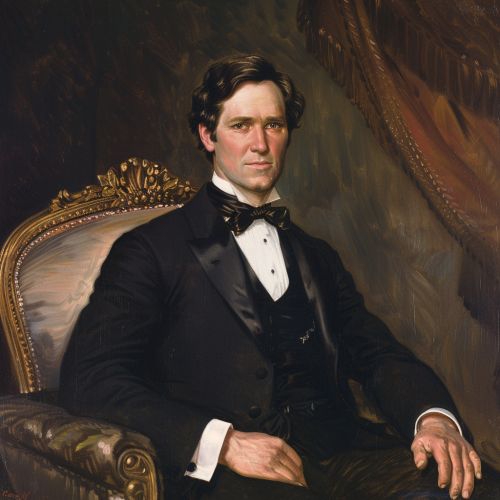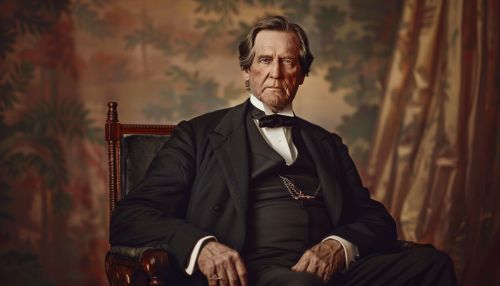Brigham Young: Difference between revisions
(Created page with "== Early Life and Background == Brigham Young was born on June 1, 1801, in Whitingham, Vermont, United States. He was the ninth of eleven children born to John Young and Abigail Howe. His father was a farmer and Revolutionary War veteran, and his mother was known for her piety and industrious nature. The Young family moved several times during Brigham's childhood, eventually settling in Mendon, New York, where Brigham worked as a carpenter, joiner, and painter. Young's...") |
No edit summary |
||
| Line 27: | Line 27: | ||
== Establishment of Utah Territory == | == Establishment of Utah Territory == | ||
[[Image:Detail-93395.jpg|thumb|center|Portrait of Brigham Young in formal attire, seated.|class=only_on_mobile]] | |||
[[Image:Detail-93396.jpg|thumb|center|Portrait of Brigham Young in formal attire, seated.|class=only_on_desktop]] | |||
Upon arriving in the Salt Lake Valley in 1847, Brigham Young and his followers began the arduous task of building a new community. Young's vision for the settlement was ambitious, encompassing not only the establishment of a religious center but also the creation of a thriving, self-sufficient society. | Upon arriving in the Salt Lake Valley in 1847, Brigham Young and his followers began the arduous task of building a new community. Young's vision for the settlement was ambitious, encompassing not only the establishment of a religious center but also the creation of a thriving, self-sufficient society. | ||
Latest revision as of 10:44, 22 June 2024
Early Life and Background
Brigham Young was born on June 1, 1801, in Whitingham, Vermont, United States. He was the ninth of eleven children born to John Young and Abigail Howe. His father was a farmer and Revolutionary War veteran, and his mother was known for her piety and industrious nature. The Young family moved several times during Brigham's childhood, eventually settling in Mendon, New York, where Brigham worked as a carpenter, joiner, and painter.
Young's early life was marked by hard work and limited formal education. Despite this, he developed a keen intellect and a strong work ethic. He was raised in a religious household, and his parents were devout members of the Methodist faith. This early exposure to religious teachings would later influence his spiritual journey and leadership in the Latter-day Saint movement.
Conversion to Mormonism
In 1830, Brigham Young was introduced to the Book of Mormon, a religious text published by Joseph Smith, the founder of the Latter-day Saint movement. Young was deeply moved by the book and began to study it intensely. After two years of contemplation and study, he was baptized into the Church of Christ (later renamed the Church of Jesus Christ of Latter-day Saints) on April 14, 1832, by Eleazer Miller.
Young's conversion marked the beginning of his lifelong commitment to the Latter-day Saint faith. He quickly became an active member of the church, participating in missionary work and helping to establish new congregations. His dedication and leadership skills did not go unnoticed, and he was soon called to serve in various leadership positions within the church.
Leadership in the Church
Early Leadership Roles
In 1835, Brigham Young was ordained as one of the original members of the Quorum of the Twelve Apostles, a governing body in the Latter-day Saint church. This position placed him in close association with Joseph Smith and other key leaders of the church. Young's responsibilities included missionary work, overseeing church affairs, and helping to establish new settlements.
During this period, Young played a crucial role in the church's efforts to build a strong and cohesive community. He was instrumental in organizing the Kirtland Temple in Ohio, the first temple built by the Latter-day Saints. He also helped to lead the church during times of persecution and hardship, including the forced migration of church members from Missouri to Illinois.
Succession Crisis and Leadership
In 1844, Joseph Smith was assassinated, leading to a succession crisis within the church. Brigham Young emerged as a key figure during this turbulent time, advocating for the leadership of the Quorum of the Twelve Apostles. His leadership was eventually recognized, and he was sustained as the second President of the Church of Jesus Christ of Latter-day Saints in December 1847.
As president, Young faced the monumental task of leading the church and its members to a new home in the West. He organized and directed the Mormon Exodus, a mass migration of Latter-day Saints from Nauvoo, Illinois, to the Salt Lake Valley in present-day Utah. This journey, fraught with challenges and hardships, ultimately led to the establishment of a new center for the church in the American West.
Establishment of Utah Territory


Upon arriving in the Salt Lake Valley in 1847, Brigham Young and his followers began the arduous task of building a new community. Young's vision for the settlement was ambitious, encompassing not only the establishment of a religious center but also the creation of a thriving, self-sufficient society.
Founding Salt Lake City
Young's leadership was instrumental in the founding of Salt Lake City. He oversaw the planning and construction of the city, including the layout of streets, the establishment of public buildings, and the development of irrigation systems to support agriculture. His efforts helped to transform the arid landscape into a fertile and productive region.
Under Young's direction, the Latter-day Saints built the Salt Lake Temple, a significant religious and cultural landmark. The temple's construction began in 1853 and took 40 years to complete, symbolizing the dedication and perseverance of the Latter-day Saint community.
Governance and Expansion
In addition to his religious leadership, Brigham Young played a key role in the political and economic development of the Utah Territory. He was appointed the first governor of the Utah Territory by President Millard Fillmore in 1851, a position he held until 1858. As governor, Young implemented policies to promote settlement, agriculture, and industry in the region.
Young's vision extended beyond Salt Lake City, and he encouraged the establishment of numerous settlements throughout the Utah Territory and surrounding areas. His efforts led to the founding of communities in present-day Idaho, Nevada, Arizona, and California. These settlements helped to expand the influence and reach of the Latter-day Saint church.
Controversies and Challenges
Brigham Young's leadership was not without controversy. His tenure as leader of the Latter-day Saint church and governor of the Utah Territory was marked by several significant challenges and conflicts.
The Utah War
One of the most notable conflicts during Young's leadership was the Utah War, also known as the Utah Expedition or Buchanan's Blunder. In 1857, President James Buchanan ordered a military expedition to Utah to address reports of rebellion and lawlessness. Young, fearing persecution and invasion, declared martial law and mobilized the Utah militia to resist the federal troops.
The conflict, which lasted from 1857 to 1858, ultimately ended without significant bloodshed. Negotiations led to a peaceful resolution, and a new governor was appointed to replace Young. The Utah War highlighted the tensions between the Latter-day Saint community and the federal government, as well as Young's determination to protect his people and their way of life.
Polygamy
Another major controversy during Young's leadership was the practice of polygamy within the Latter-day Saint church. Young was a prominent advocate of polygamy, and he himself had numerous wives and children. The practice of polygamy was officially sanctioned by the church in 1852, leading to widespread criticism and legal challenges.
Young defended polygamy as a religious principle and argued that it was a divine commandment. However, the practice faced increasing opposition from the federal government and the broader American society. The controversy over polygamy persisted for decades and remained a contentious issue within the church and the nation.
Legacy and Impact
Brigham Young's legacy is complex and multifaceted. He is remembered as a visionary leader who played a pivotal role in the establishment and growth of the Latter-day Saint church and the development of the American West. His contributions to the religious, social, and economic fabric of the region are significant and enduring.
Religious Leadership
As the second President of the Church of Jesus Christ of Latter-day Saints, Young's leadership helped to shape the doctrines, practices, and organizational structure of the church. He was instrumental in the establishment of key institutions, including the Perpetual Emigrating Fund, which assisted thousands of converts in migrating to Utah. His teachings and writings continue to influence the faith and practices of Latter-day Saints today.
Pioneer and Settler
Young's role as a pioneer and settler is a central aspect of his legacy. His leadership during the Mormon Exodus and the establishment of settlements throughout the West helped to lay the foundation for the growth and development of the region. His efforts in building infrastructure, promoting agriculture, and fostering community cohesion were critical to the success of the Latter-day Saint settlements.
Controversial Figure
Despite his many accomplishments, Young remains a controversial figure. His advocacy of polygamy, his role in the Utah War, and his sometimes authoritarian leadership style have been subjects of criticism and debate. Historians and scholars continue to examine and reassess his impact and legacy, considering both his achievements and the controversies that marked his tenure.
See Also
- Joseph Smith
- Salt Lake City
- Mormon Exodus
- Quorum of the Twelve Apostles
- Polygamy in the Latter-day Saint movement
